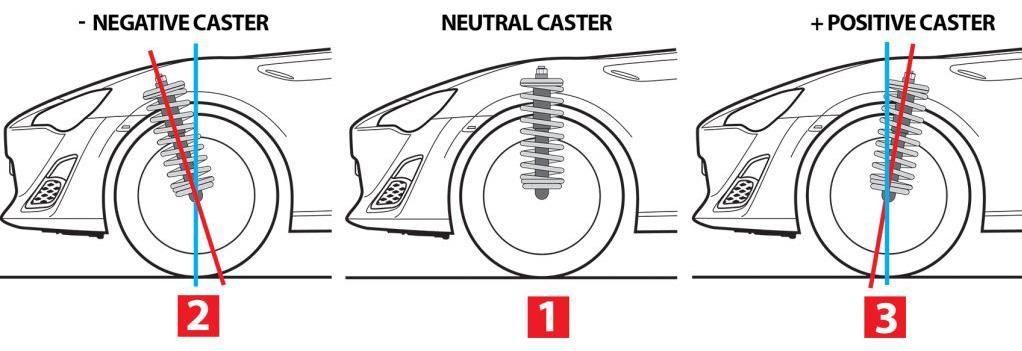What is Caster and Its Effects On Vehicle Performance?
In this article, we’re going to focus on what is caster and its effects on a vehicle’s performance.
Three common measurements form the suspension geometry of a motor vehicle. Caster is one of them, while the other two are camber and toe. You can adjust these variables to correct the suspension angle and fix various car problems.
Remember that the suspension system involves tires and their pressure, shock absorbers, springs, and linkages—all components that connect a car’s framework to the wheels.
So, you can imagine how important these three measurements are.
What Is Caster?
Caster, also known as the caster angle, is the slant measured from the top of the steering axis to the bottom of the wheel when the former is attached to the latter. This angle evaluates the back and forth incline of the axis.
In simple words, this is an alignment adjustment that occurs only on the front wheels when they are turning. It’s measured on the steering wheels when viewing the vehicle side-wise.
To visualize the angle, you can imagine the steering axis connecting the lower pivot point or ball joint with their upper counterpart, respectively. This formation creates a gradient with the steep line going straight through the bottom pivot point.

The easiness to steer the wheel and a vehicle’s stability depend on the caster. Zero or neutral caster will create a perfect vertical shock or spring.
Based on the suspension type, the wheel’s position will be at the south of the upper ball joint or strut point while the axis axis will be vertical to the road.
Positive caster happens when the wheel and lower pivot point stay before its upper counterpart.
Vehicles these days apply this caster angle to prevent inadvertent vehicle turning or veering from the straight trajectory when driving at a high speed.
Negative caster occurs when the upper pivot point stays in front of the lower pivot point. When the vehicle strays from the straight line you intend to drive toward, it indicates the presence of a negative caster.
SEE MORE:
Positive Caster vs Negative Caster
We’ve already discussed what is caster and how it becomes positive or negative. Now, let’s find out the effects of these angles.
The effects of a positive caster
As you already know, a positive caster occurs when the steering axis tilts in front of the axis of the car. It pushes the coil spring over the shock to the rear side of the vehicle at the time of driving.
A driver can distinctly feel the effects of a positive caster when driving the car in a forward movement.
Due to the huge amount of self-aligning torque on the front tires and wheels created by the upper ball joint or strut mount, the vehicle will be steady on its track when you drive straight.
The effect of this caster angle generates a tension that keeps the front wheels straight at the time of driving at speeds.
Another effect of this torque is the steering wheel’s returning to the 12 o’clock position when driving around a corner. Otherwise, the car will wander off from its straight route.
Positive caster is crucial in enhancing the cornering and handling performance of a vehicle. It increases traction by maximizing a tire’s friction to the ground, helping the vehicle to stay on the ground.
Increasing the positive caster too much is not a good idea because it will make the steering heavier and hard to rotate.
However, you don’t need to worry about this in modern vehicles as they have a power steering system to cancel the heaviness in the steering wheel.
Another problem is it can hasten tire wear, although the effect is not direct. Tire and wheel misalignment along with excessive positive caster can worsen the tire wear issue.
The effects of a negative caster
What is caster when it turns negative? In this case, the steering axis tilts behind the vehicle’s vertical axis. Most old cars suffer from this problem because of the absence of a power steering system.
Setting a negative caster was the only way to make the rotation of the steering wheel easier in those cars.

Due to this negative caster, the steering wheel in older vehicles often feels too light, and it becomes hard to keep the vehicle on track during turning a corner.
FAQs
1. What are the effects of positive caster on vehicle performance?
Positive caster tends to enhance straight-line stability and steering returnability.
It provides a self-centering effect, making the vehicle’s wheels naturally want to return to the straight-ahead position after a turn. This improves high-speed stability and helps maintain a straight path when driving.
2. Are there any drawbacks to having a high positive caster angle?
While positive caster has its benefits, excessive positive caster can lead to heavier steering effort at low speeds, making parking and maneuvering more challenging.
It can also increase the likelihood of “caster shimmy” or vibrations in the steering system if not properly balanced.
3. How does caster angle affect tire wear?
A6: Incorrect caster angles can lead to uneven tire wear. Excessive positive caster can cause the tires to wear on their outer edges, while excessive negative caster can lead to inner edge wear. Properly balanced caster helps ensure even tire wear and maximizes tire life.
4. Can the caster angle be adjusted on a vehicle?
Caster angle can often be adjusted by a qualified mechanic or at an alignment shop. Adjusting caster typically involves altering the position of the upper or lower control arm mounting points, depending on the vehicle’s suspension design.
5. Is the caster angle the same for all vehicles?
No, caster angles vary from one vehicle to another and are determined by the vehicle’s design and intended use.
Different types of vehicles (e.g., sports cars, trucks, or sedans) may have different caster angles to optimize their handling characteristics.
Check out this video from Engineering Explained to learn what is caster and how does it work!
The Final Words
The power steering system is a revolutionary addition to modern vehicles. By making use of positive caster, this system increases road and driving safety by promoting a stable driving performance.
Cars these days are engineered in a way that their chassis and engine framework won’t support negative caster.
If your vehicle pulls toward a side during driving at highway speed or making a corner, you should diagnose it for suspension misalignment.














